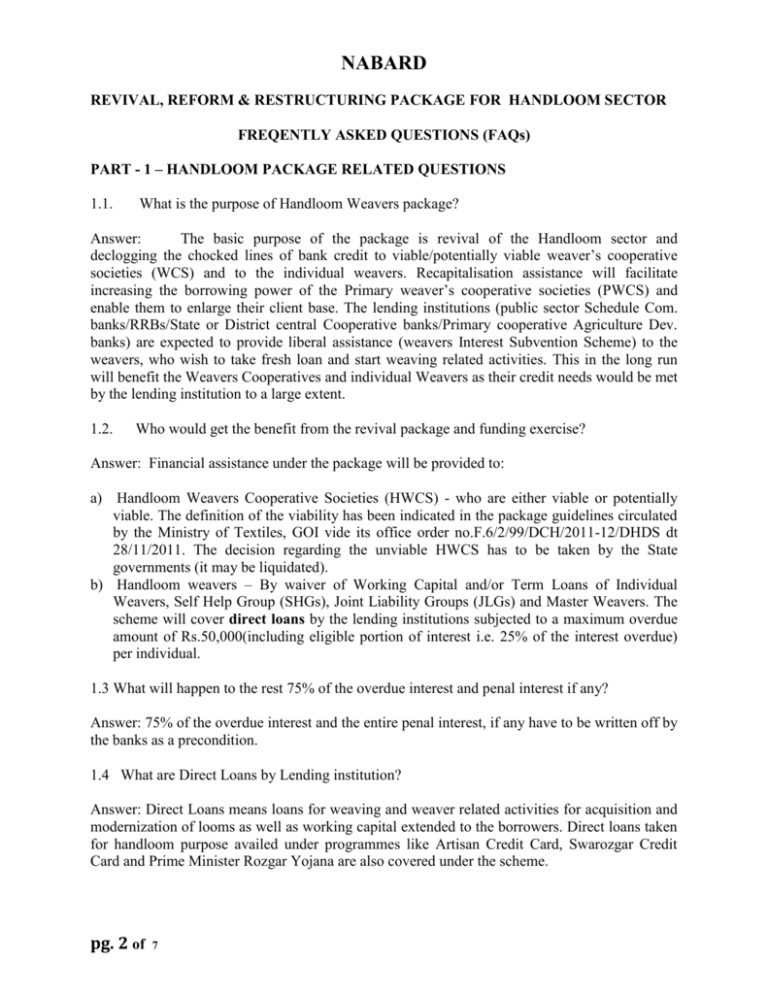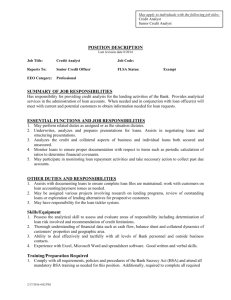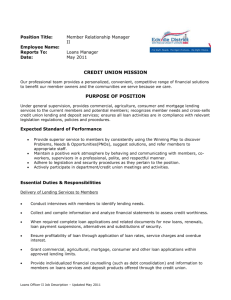FAQs Handloom Package
advertisement

NABARD REVIVAL, REFORM & RESTRUCTURING PACKAGE FOR HANDLOOM SECTOR FREQENTLY ASKED QUESTIONS (FAQs) PART - 1 – HANDLOOM PACKAGE RELATED QUESTIONS 1.1. What is the purpose of Handloom Weavers package? Answer: The basic purpose of the package is revival of the Handloom sector and declogging the chocked lines of bank credit to viable/potentially viable weaver’s cooperative societies (WCS) and to the individual weavers. Recapitalisation assistance will facilitate increasing the borrowing power of the Primary weaver’s cooperative societies (PWCS) and enable them to enlarge their client base. The lending institutions (public sector Schedule Com. banks/RRBs/State or District central Cooperative banks/Primary cooperative Agriculture Dev. banks) are expected to provide liberal assistance (weavers Interest Subvention Scheme) to the weavers, who wish to take fresh loan and start weaving related activities. This in the long run will benefit the Weavers Cooperatives and individual Weavers as their credit needs would be met by the lending institution to a large extent. 1.2. Who would get the benefit from the revival package and funding exercise? Answer: Financial assistance under the package will be provided to: a) Handloom Weavers Cooperative Societies (HWCS) - who are either viable or potentially viable. The definition of the viability has been indicated in the package guidelines circulated by the Ministry of Textiles, GOI vide its office order no.F.6/2/99/DCH/2011-12/DHDS dt 28/11/2011. The decision regarding the unviable HWCS has to be taken by the State governments (it may be liquidated). b) Handloom weavers – By waiver of Working Capital and/or Term Loans of Individual Weavers, Self Help Group (SHGs), Joint Liability Groups (JLGs) and Master Weavers. The scheme will cover direct loans by the lending institutions subjected to a maximum overdue amount of Rs.50,000(including eligible portion of interest i.e. 25% of the interest overdue) per individual. 1.3 What will happen to the rest 75% of the overdue interest and penal interest if any? Answer: 75% of the overdue interest and the entire penal interest, if any have to be written off by the banks as a precondition. 1.4 What are Direct Loans by Lending institution? Answer: Direct Loans means loans for weaving and weaver related activities for acquisition and modernization of looms as well as working capital extended to the borrowers. Direct loans taken for handloom purpose availed under programmes like Artisan Credit Card, Swarozgar Credit Card and Prime Minister Rozgar Yojana are also covered under the scheme. pg. 2 of 7 1.5 As per the annexure III clause 3.1(1), direct loans taken for handloom purpose availed under programmes like Artisans Credit Card, Swarozgar Credit Card and PMRY etc are eligible, whether direct loans granted by banks in other schemes are also covered under the scheme? Ans – Yes, Overdues on all loans given for weaving and weaving related activity and overdue as on 31 March 2010 are eligible . Term loans sanctioned for acquisition and modernization of looms as well working capital extended to the categories of borrowers as indicated in Para 2.1 of annexure III clause 3.1(1) of the scheme Guidelines are covered under the package. Loans which are given to Master Weavers to support weavers under them, as per records in the bank established by prior documentation with the lending institution, are also included. PART - 2 - PACKAGE IMPLEMENTATION RELATED QUESTIONS 2.1 When will the implementation of the package start? Answer: From the Financial Year 2011-12. 2.2 Who are special categories states as per the package? Answer: North-East states including Sikkim, Jharkhand, Chhattisgarh, Uttaranchal, Himachal Pradesh, and Jammu & Kashmir. 2.3 Is fresh loaning by banks a must for waiver of individual weaver loans? Answer: Yes, those weavers loan accounts which are eligible under the scheme will only be considered for loan waiver only when banks agree to extend fresh loan of at least Rs.20,000. 2.4 What is cheap credit to fresh loans taken by individual weavers and WCS? Answer: Interest Subvention (IS) of 3% for 3 years would be extended from the date of disbursement of fresh loan extended by the banks to eligible WCS and individual handloom weavers. The IS scheme will not be available after the date on which a loan becomes nonperforming asset. 2.5 What is credit Guarantee provided by CGTMSE? Answer: Govt. will make necessary provision for Payment of Guarantee Fee @1% and annual Service Fee @0.5% to CGTMSE, for credit guarantee for a period of 3 years from the date of first disbursal of the fresh loan. 2.6 How will the recapitalization assistance be released? Answer:80% of the Govt. of India share will be released upon signing of the MOU by the State Govt. and completion of special audit by NABARD. Balance 20% will be released upon fulfillment of commitments by the State Govt. concerned after completing the legal & institutional reform as per the MOU. pg. 3 of 7 2.7 What will happen to the receivable such as subsidies etc. from State and Central Govt. (Including institutions/Agencies under the control of State govt.)? Answer: Such receivable which are of the nature of prior commitments from the State and Central Govt., including institutions/Agencies under the control of State govt.will have to be paid upfront by the respective Govt.‘s as a precondition (outside the package). 2.8 Who will bear the cost of frauds, embezzlement and misappropriation etc. of the PWCS/AWCS? Answer: Such cost have to be borne by the respective institution i.e PWCS/AWCS. 2.9 Do all the districts have to constitute a District Implementation, Monitoring and Review Committee (DIMRC)? Answer: All districts may not constitute a DIMRC. A cluster approach can be adopted depending upon the number of viable and potentially viable PWCS (identified by the state govt. as per the audit of the year 2009-10). 2.10 Should interest be applied after the date when the loan account is classified as NPA? Answer: In case of NPA loan, no interest should be applied from the date when the loan account is classified as NPA. Hence, interest on loans classified as NPA, for any period after it is so classified, can not be claimed from Govt. 2.11 Will insurance premium/inspection charges levied by the lending institution qualified for waiver assistance? Answer: Such charges will not qualify for waiver assistance from GOI/State govt. 2.12 What will happen to back ended subsidy under any govt. sponsored scheme? Answer: Such subsidy will have to be netted by the lending institution before arriving at the waiver amount. 2.13 Who is a master weaver? Answer: Master Weaver is one who employs weavers on wage basis on their own/hired looms and guiding/providing them various support services. He may be engaged in production and marketing of cloths and should not be functioning only as a trader who merely procure finished goods and sells them. 2.14 Do restructure/reschedule loan covered under the package? Answer: The Package excludes the loans restructure/reschedule in the normal course by the lending institution in the past under any GOI/state govt. schemes or under OTS of the bank as per RBI guidelines, being covered under SARFAESI Act. However as per the decision taken in the first and Second NIMRC meeting, If the bankers want to cover loans already covered under SARFAESI Act under the existing loan waiver, it is pg. 4 of 7 compulsory on the part of Banks to withdraw their proceedings against their borrowers. Costs of RC Accounts have to be borne by the banks. 2.15 What will happen, in case the overdue loan amount including interest exceeds Rs. 50,000? Answer: In terms of Para 5.2.(iv) of the Annexure III of the GoI Scheme ,in case the overdue loan amount including interest exceeds Rs 50, 000/-, then the amount of waiver assistance under this package will be restricted to Rs 50,000/- and amount exceeding this limit may be either claimed from the weaver borrower or waived off by the lending institutions. Bank may take a decision accordingly in conformity with the package guidelines. 2.16 What will be the fate of bad loans disbursed by the lending institution after 31/03/2010? Answer: Nothing contained in this scheme shall apply to the loans disbursed after 31/03/2010. 2.17 The name of the Authority, who will vet the list of eligible borrowers to be covered under the package prepared by the branches of lending institution Answer: Lending Institutions are expected to assess the claims in their branches strictly in terms of the Govt. of India Scheme. The audit may be conducted by concurrent auditors, statutory auditors or special auditors as may be directed by Govt. of India before claims being forwarded to NABARD. Measures like identification of borrowers, display of borrowers list, obtaining undertaking to carry out handloom activity in future and avail fresh credit as per bank terms & conditions etc as prescribed in the scheme may be adhered to. The ultimate responsibility of implementing the scheme successfully rests with the lending institutions 2.18 What has to be done by a branch of a lending institution covered under the scheme? Answer: A copy of the scheme shall be displayed in each branch of lending institution covered under the package. Such branch shall prepare a list of borrowers who are eligible for waiver under the scheme after ascertaining that the borrower is a handloom weaver and the loans were given for handloom weaving purpose. Credit needs in future for such borrowers has to be assessed as well. The list shall be displayed on the notice board of the branch. The shortlisted borrower should be approached by a formal letter seeking his willingness to take up handloom weaving activity in future by availing credit from the lending institution. 2.19 What will be the rate of interest for fresh credit given by the lending institution? Answer: In terms of the decision taken in the First NIMRC meeting held on 26/12/2011 , There is no cap on the rate of int. to be charged from the ultimate borrower . 2.20 Who will have the power to interpret and resolve the issues regarding the scheme? Answer: NIMRC shall resolve the issues and the decision of the NIMRC will be final. 2.21 Can the State Govt. accept the package in part or in toto? pg. 5 of 7 Answer: Although the willingness to participate in the package is optional, once exercised the concerned state govt. and the weaver society would have to accept the package in toto. 2.22 It is mentioned in the Guidelines that date of notification of the scheme of Ministry of Textiles GOI is 28th Nov. 2011. In the draft of the scheme, it is also mentioned that the process of implementation of the scheme will be started within 60 days from the date of notification by identifying the weavers unit eligible for the waiver under the scheme and exhibiting the list thereof on the Notice Board of the Branch. Whether the list of eligible Weaver’s units should be disposed in the branches all over India irrespective of Letter of Commitment received from the State Government before 27/01/2012? Answer: The start of the implementation of the Weavers’ Package in a state will commence only after the scheme is approved by the respective State Governments and Letter of Commitment (LOC) received. However, The Scheme guidelines have already been circulated to all Banks by NABARD and also Ministry Of Textiles. It is expected to be discussed in the Special SLBC meeting to be convened in each State. As discussed in the second NIMRC meeting at Delhi on 04th January 2012, the branches of the banks should keep themselves in readiness and prepare a list of borrowers eligible for loan waiver under the scheme norms internally. PART - 3 - SPECIAL AUDIT RELATED QUESTIONS 3.1. What is the objective of Special audit? Answer:For the purpose of recapitalization assessment of handloom WCS special audit manual is drafted. It not only provides detail guideline to auditors but also facilitate working out the actual recapitalization amount. It gives insight of the functioning of PWCS, AWCS and highlights the problem and possible solution. The special audits of the AWCS/PWCS are being taken with reference to their financial position as on 31 March, 2010. 3.2. Whether special audit tantamount to re audit? Answer: No, special audit is not a re audit. The special audit is limited to assessment and quantification of losses correctly as on 31 March, 2010 after making due provisions as per the norms prescribed under the package . 3.3. Whether special audit of a society can be conducted if the society was not audited with reference to its financial position as on 31 March, 2010? Answer: As the audit conducted by the Cooperative Auditors with reference to its financial position as on 31 March, 2010 would form the basis for special audit, the special audit cannot be conducted on those societies which are not audited till date. 3.4. Whether the societies established after 31 March, 2010 have to be covered under special audit? pg. 6 of 7 Answer: Only those PWCS which were functioning as on 31 March, 2010 and whose books have been audited for the year ended 31 March, 2010 need to be audited, as they only would qualify for recapitalization support under the scheme. 3.5. If in the opinion of the auditor, the value of fixed asset (land and building) held by the society has appreciated in value whether such appreciated value has to be reckoned? Answer: The auditors are not required to make revaluation of assets and effect adjustment in the accumulated losses on account of appreciation in value of fixed assets like land and building. They have to ensure that the adequate depreciation is made against the fixed assets held. 3.6. How to assess the provisioning requirement in respect of fictitious loans? Answer: If the inspection of societies conducted by the bank revealed that a portion of the loan portfolio are fictitious and to this effect an observation has been made in the normal audit as on 31 March, 2010, conducted earlier, then the entire loan assets may be regarded as loss assets. As this loss had occurred on account of society’s own mismanagement, this may deemed as “fraud”. As such losses cannot be compensated by the State/Central Governments under the scheme, they would have to be borne by the society itself. 3.7. Loans Outstanding at Society level includes irregular loans by Society Secretary amounting to frauds. Whether 100% provisioning is required on such loans ? Answer: Yes. This will be borne by the Society. 3.8.In case the audit note of 31.03.10 bear remarks like specific amounts are recoverable from office bearer of the society, whether such amounts are to be shown against society or GoI / State Govt.? Answer: Such amounts are to be borne by the society. 3.9. In case value of the property as per auditor is more than the Book Value, whether higher value is to be considered? Answer: No. The amount shown in the Balance sheet of the society as of 31.03.10 is to be considered. 3.10 WCS are making investments in the shares of other cooperative socieities at the behest of the State Government and hence, the lossess arising out of such investments have to be borne by the State Government/Govt of India and not WCSs Answer: As the investments decisions are taken at board level of WCSs, the losses have to be shared by WCSs although it has been done at the behest of the State Government. pg. 7 of 7







